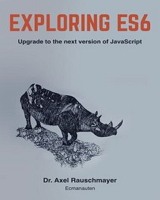
Exploring ES6: Upgrade to the next version of JavaScript
- Length: 555 pages
- Edition: 1
- Language: English
- Publisher: Leanpub
- Publication Date: 2015-10-03
You are reading a book about ECMAScript 6 (ES6), a new version of JavaScript. It’s great that we can finally use that version, which had a long and eventful past: It was first conceived as ECMAScript 4, a successor to ECMAScript 3 (whose release was in December 1999). In July 2008, plans changed and the next versions of JavaScript were to be first a small incremental release (which became ES5) and then a larger, more powerful release. The latter had the code name Harmony and part of it became ES6.
Table of Contents
Part I Background
Chapter 1 About ECMAScript 6 (ES6)
Chapter 2 FAQ: ECMAScript 6
Chapter 3 One JavaScript: avoiding versioning in ECMAScript 6
Chapter 4 First steps with ECMAScript 6
Chapter 5 Deploying ECMAScript 6
Part II Data
Chapter 6 New number and Math features
Chapter 7 New string features
Chapter 8 Symbols
Chapter 9 Template literals and tagged templates
Chapter 10 Variables and scoping
Chapter 11 Destructuring
Chapter 12 Parameter handling
Part III Modularity
Chapter 13 Callable entities in ECMAScript 6
Chapter 14 Arrow functions
Chapter 15 New OOP features besides classes
Chapter 16 Classes
Chapter 17 Modules
Part IV Collections
Chapter 18 New Array features
Chapter 19 Maps and Sets
Chapter 20 Typed Arrays
Chapter 21 Iterables and iterators
Chapter 22 Generators
Part V Standard library
Chapter 23 New regular expression features
Chapter 24 Asynchronous programming (background)
Chapter 25 Promises for asynchronous programming
Part VI Miscellaneous
Chapter 26 Unicode in ES6
Chapter 27 Tail call optimization
Chapter 28 Meta programming with proxies
Chapter 29 Coding style tips for ECMAScript 6







